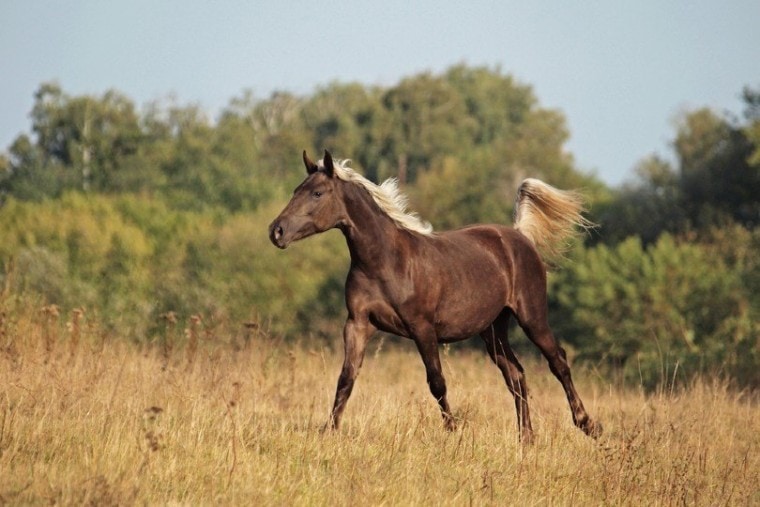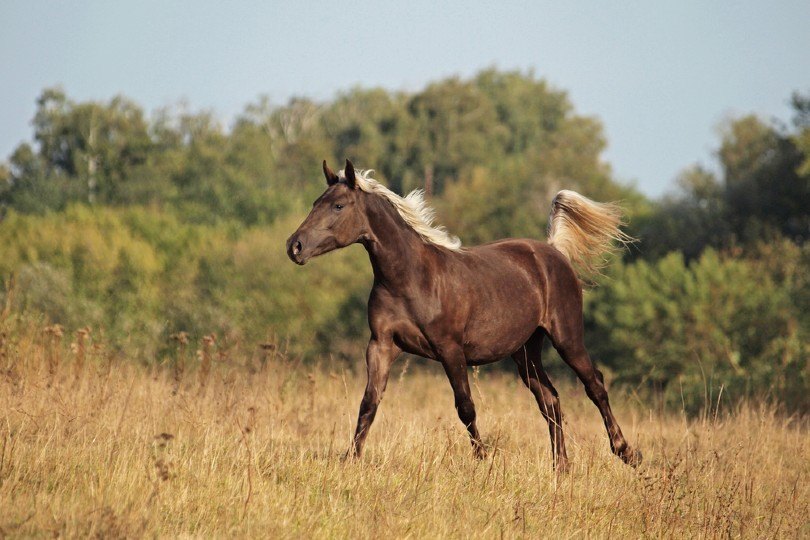
Click to Skip Ahead
Did you know the Rocky Mountain horse did not actually originate from the Rocky Mountains? It actually originated in the Appalachian Mountains in Kentucky. The breed is surefooted and good-natured, making it perfect for riders who want a smooth ride. But that’s not it. Rocky Mountain horses can also pull carriages, run through mountain trails, and partake in show-ring competitions.
| Care Level | Moderate |
| Temperature | Cold hardy |
| Temperament | Well-mannered and docile |
| Colors | Chestnut, palomino, bay, and black |
| Lifespan | 30–37 years |
| Weight | 850–1,000 pounds |
| Height | 14–16 hands (64 inches) |
Stories about the origin of the Rocky Mountain horse have been passed down through generations. In the 1800s, the Rocky Mountain horse type began. A prominent breeder used Old Tobe, a stallion, in the mid-1900s to create the modern Rocky Mountain horse. The Rocky Mountain Horse Association came into being in 2005. It currently has more than 12,000 registered horses.
Rocky Mountain Horse Characteristics
What Are These Horses Used For?
Rocky Mountain horses are very versatile. Since they have a comfortable gait and social temperament, they’re often used as pleasure horses. They are also chosen for trail riding. Their hardy nature allows them to be surefooted even on uneven terrain.
A contemporary use of the Rocky Mountain horse is in the show ring, where they dazzle and impress spectators with their beauty and impressive movements. They are often the stars in eventing and dressage competitions.
Rocky Mountain horses are also popular in carriage driving, both competitively and leisurely. Since they are docile, they also make good horses for beginners and children.

Where Did These Horses Originate From?
As mentioned earlier, Rocky Mountain horses originated in Kentucky between the 1800s and 1900s. As their breeding increased in the area, they retained their characteristics. Most people who owned these horses were poor and could not afford demanding upkeep. As a result, horses that couldn’t withstand harsh winter temperatures died. Those with hardy traits survived and passed on their hardiness to the future generation of Rocky Mountain horses.
Sam Tuttle, a breeder in Spout Springs, brought a Rocky Mountain horse called Old Tobe from the Rocky Mountain region. He bred Rocky Mountain horses for a long time because the breed could carry inexperienced riders through all sorts of terrain. Today, many of the Rocky Mountain horses retain the characteristics passed down by Old Tobe.
After World War II, the population of horses declined significantly in the US. However, Tuttle kept breeding his herd, and Old Tobe bred till he turned 34. Old Tobe died at 37 years of age.
In 1986, when the Rocky Mountain Horse Association was formed, it only had 26 horses in the first registration. Since then, the association has expanded to 11 countries. The association conducts DNA testing on a foal to ensure their heritage. After the horse turns 23 months old, the association inspects them to see if they meet the gait and physical requirements.
Currently, the American Livestock Breeds Conservancy has kept Rocky Mountain horses on the ”Watch” list because their global population is under 15,000.
Temperament & Intelligence of the Rocky Mountain Horse
The Rocky Mountain horse has a calm and gentle personality that makes them easy to train. Since the breed requires human companionship, they make loyal and affectionate companions. They love to be groomed and need attention from the handler.
Appearance & Varieties
On average, the Rocky Mountain horse is 14 to 16 hands in height. They have sloping shoulders and deep chests, with medium-sized heads and well-defined ears. Their hind legs are angled to support their gait.
The breed is known for their solid-colored chocolate coat. But they may also be chestnut, bay, black, or palomino in color. Horses with too much white on their faces, hock, or knees are not accepted into the Rocky Mountain Horse Association.
These horses have a long, flowing mane and tail. The mane may be thick, falling on the side of the neck, whereas the tail gives the breed an elegant appearance since it can grow quite long.
There are two main varieties of the Rocky Mountain horse: Mountain Pleasure and Classic. Both types are pretty similar, except that the Mountain Pleasure Rocky Mountain horses have a smoother gait and stockier build than their Classic counterparts, with a light and refined build.

Things to Know When Owning a Rocky Mountain:
Taking care of a Rocky Mountain horse isn’t hard as long as you provide them with the right living conditions, exercise, and diet. Here’s what you need to know to keep your horse happy and healthy:
Habitat & Stable Requirements
Experts recommend providing more square footage to larger horses. A 12-foot x 12-foot stall will be ideal for a 1000-pound Rocky Mountain horse. It’s not recommended to make the walls shorter than 10 feet tall.
The doors of the stable should be durable and have secure latches. Do not make the door so low that your horse jumps over it. Also, keep the latch out of your horse’s reach since Rocky Mountain horses like to use their intelligence to try operating the doors.
Make sure your horse is well-sheltered in the winter too. Providing adequate shelter will allow your horse to tolerate temperatures down to -40 degrees Fahrenheit.
Food & Diet Requirements
Rocky Mountain horses need a well-balanced diet comprising water, vitamins, fats, carbohydrates, proteins, and minerals. You can feed them hay, fresh grass, and rolled oats. Also, incorporate other grains into the mix, including bran and barley.
When training your horse, you can also give them some treats to encourage positive reinforcement. Some examples of treats for your Rocky Mountain horse are apples and carrots.
On average, a horse eats about 1% to 2% of their body weight. For instance, if your horse weighs 1,000 pounds, they will need about 10 to 20 pounds of food daily. If you plan to introduce something new into your horse’s diet, give it to them gradually over 5 days to a week to prevent digestive issues like laminitis and colic.
Exercise
If your horse lives in a pasture with the herd, they will get some exercise since they have to move around to find plants. But if they live in a stable, you must make sure they get enough exercise regularly. You can take your horse for daily rides and use small jumps to test their athleticism.

Training
Training your Rocky Mountain horse will require you to build a bond with them. The sooner you start this, the easier the process will be for you. Start bonding with your horse when they are two to three years of age.
After that, master some groundwork, like teaching them how to move correctly and respond to your commands. Then, you can begin saddling and bridling.
Grooming
Brushing a horse’s face, legs, saddle area, and girth is important to properly distribute the skin’s oils. Use a detangler on your pet’s tail to brush out the knots.
You must also get your horse’s coat clipped by a professional. Experts state that unclipped horses sweat excessively in the summer. In winter, they may catch a cold if you put them away sweaty.
Besides clipping, you also need to brush away the debris from the horse’s coat, clean their hoofs, and comb through the mane.
Lifespan & Health Conditions
As amazing as Rocky Mountain horses are, they are also prone to several health conditions.
Serious Conditions
Rocky Mountain horses are highly susceptible to multiple congenital ocular anomalies (MCOA), a genetically ocular syndrome. It’s a non-progressive disease that causes abnormal development of ocular tissue, resulting in obstructed vision. Studies show that the genetic disorder may be due to a gene called the silver dapple gene that affects the coat color of Rocky Mountain horses.
Minor Conditions
Some minor health conditions horses are susceptible to include colic, flu, tetanus, and equine encephalitis. All of these can be prevented with proper vaccinations and regular veterinary care.
Male vs Female
Rocky Mountain mares and stallions differ in their size and build. Stallions tend to be stronger, stockier, and bigger than mares. They also weigh more and can often outrun their female counterparts.
3 Little-Known Facts About Rocky Mountain Horse
1. You Can Find Rocky Mountain Horse Trainers Online
The Rocky Mountain Horse Association has an online repository where you can find breeders, trainers, and equine services certified by the association.
2. Old Tobe’s Main Trait Was Longevity
One of the main characteristics of Old Tobe was longevity, which he passed on to his offspring. Many of them bred till their early thirties.
3. Rocky Mountain Horses Can Go 7 Miles an Hour
Rocky Mountain horses use their single-foot ambling gait to travel 7 miles of rough ground and 16 miles of smooth ground per hour.

Final Thoughts
The Rocky Mountain horse is an ideal pick for older people with joint pain or young children with little to no horse riding experience. Since the breed is hardy, these horses can thrive in many environments, from cold to temperate climates.
Finding a Rocky Mountain horse may be tricky since there’s a limited quantity. Make sure you buy a horse from a breeder registered at the Rocky Mountain Horse Association to ensure it is a certified purebred.
Featured Image Credit: Shawn Hamilton, Shutterstock








